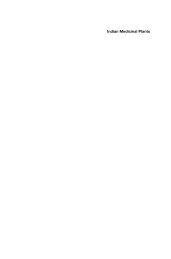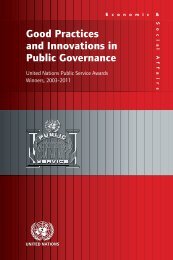a-collection-of-research-articles-on-the-medical-potential-of-cow-urine
a-collection-of-research-articles-on-the-medical-potential-of-cow-urine
a-collection-of-research-articles-on-the-medical-potential-of-cow-urine
You also want an ePaper? Increase the reach of your titles
YUMPU automatically turns print PDFs into web optimized ePapers that Google loves.
Randhawa and Sharma: Chemo<strong>the</strong>rapeutic <strong>potential</strong> <str<strong>on</strong>g>of</str<strong>on</strong>g> <strong>cow</strong> <strong>urine</strong><br />
FUNGICIDE AND BIOFUNGICIDE<br />
Fungicidal effect against Aspergillus fumigatus, Aspergillus<br />
flavus, Aspergillus niger, Aspergillus, Malassezia, C. tropicalis<br />
and C. glabrata has been observed in various studies. CU was<br />
highly stable and capable in inhibiting <strong>the</strong> growth <str<strong>on</strong>g>of</str<strong>on</strong>g> Malassezia<br />
fungi (90-95%) resp<strong>on</strong>sible for causing dandruff for a l<strong>on</strong>ger time<br />
(4-5 days), than rice water (due to B. cereus growth in rice water)<br />
which was stably capable <str<strong>on</strong>g>of</str<strong>on</strong>g> inhibiting 85-90% <str<strong>on</strong>g>of</str<strong>on</strong>g> <strong>the</strong> growth for<br />
3-4 days. Neem leaves extract and Lem<strong>on</strong> Juice extract were<br />
comparatively less effective in this study [40].<br />
15% CU was most active against Aspergillus, Rhizophus and<br />
<strong>the</strong> percentage <str<strong>on</strong>g>of</str<strong>on</strong>g> inhibiti<strong>on</strong> obtained with it was 85% [41].<br />
5% CUC showed maximum antifungal activity against A. niger<br />
(93%), followed by A. oryzae (92.67%) and A. flavus (83%)[30].<br />
CUD showed better antifungal activity against A. fumigatus<br />
and C. albicans with mean z<strong>on</strong>e <str<strong>on</strong>g>of</str<strong>on</strong>g> inhibiti<strong>on</strong> <str<strong>on</strong>g>of</str<strong>on</strong>g> 13 and 11 mm<br />
than PhCU [27]. More fungal growth suppressi<strong>on</strong> (as mm in<br />
diameter) was observed with CUD in A. niger (8 ± 0.14, 11.3<br />
± 1.2 and 12.6 ± 0.04, respectively) than A. flavus (7.3 ± 0.25,<br />
10 ± 0.26 and 11 ± 1.2, respectively) with <strong>the</strong> use <str<strong>on</strong>g>of</str<strong>on</strong>g> 5, 10 and<br />
15 μl <str<strong>on</strong>g>of</str<strong>on</strong>g> CUD [34].<br />
In vitro antifungal activity (in mm) <str<strong>on</strong>g>of</str<strong>on</strong>g> Geer CU against A. flavus<br />
(17.33 ± 0.57) was in between 50 μg <str<strong>on</strong>g>of</str<strong>on</strong>g> amphotericin B (15)<br />
and 10 μg <str<strong>on</strong>g>of</str<strong>on</strong>g> clotrimazole (24) and against C. albicans, activity<br />
was similar with CU (18.67 ± 1.15) and amphotericin B (19),<br />
but less than clotrimazole (30) [28]. Antifungal activity <str<strong>on</strong>g>of</str<strong>on</strong>g><br />
Geer CU is better than <strong>the</strong> o<strong>the</strong>rs where source <str<strong>on</strong>g>of</str<strong>on</strong>g> CU is not<br />
menti<strong>on</strong>ed.<br />
In an in vitro study, it was found that <strong>the</strong> <strong>urine</strong> samples <str<strong>on</strong>g>of</str<strong>on</strong>g><br />
outdoor feeding <strong>cow</strong> (OCU) was more effective and inhibited<br />
growth <str<strong>on</strong>g>of</str<strong>on</strong>g> fungi more str<strong>on</strong>gly as compared to indoor feeding<br />
CU (ICU). This inhibiti<strong>on</strong> was c<strong>on</strong>centrati<strong>on</strong> dependent.<br />
No growth <str<strong>on</strong>g>of</str<strong>on</strong>g> Penicillium notatum, Trichoderma viridae, and<br />
Alternaria solanii was observed with 10% OCU and with 20%<br />
ICU and that <str<strong>on</strong>g>of</str<strong>on</strong>g> Claviceps purpurea, Rhizopus oligosporius, C.<br />
albicans and A. candidus, no growth was observed with 20% <str<strong>on</strong>g>of</str<strong>on</strong>g><br />
OCU <strong>on</strong>ly [42].<br />
ANTISEPTIC<br />
Sanganal et al. observed <strong>the</strong> enhanced wound healing activity<br />
<str<strong>on</strong>g>of</str<strong>on</strong>g> CU in Wistar albino rats [43]. On 4 th day, <strong>the</strong> external<br />
applicati<strong>on</strong> <str<strong>on</strong>g>of</str<strong>on</strong>g> CU showed significant and progressive increase<br />
in wound healing in rats compared to different c<strong>on</strong>centrati<strong>on</strong>s<br />
<str<strong>on</strong>g>of</str<strong>on</strong>g> CU and 1% w/w nitr<str<strong>on</strong>g>of</str<strong>on</strong>g>uraz<strong>on</strong>e ointment locally. Similar<br />
findings were also observed by Maheshwary et al. [44].<br />
ANTHELMINTIC ACTIVITY<br />
CUC was found to be more effective than piperazine citrate<br />
as an<strong>the</strong>lmintic agent at both 1% and 5% c<strong>on</strong>centrati<strong>on</strong>s.<br />
For an<strong>the</strong>lmintic activity, adult Indian earthworm Pheretima<br />
posthuma was studied due to its anatomical and physiological<br />
resemblance with <strong>the</strong> intestinal roundworm parasite <str<strong>on</strong>g>of</str<strong>on</strong>g> human<br />
beings. Paralysis <str<strong>on</strong>g>of</str<strong>on</strong>g> earthworm occurred in 53 and 48 min<br />
with 1% piperazine and CUC, respectively and 16 and 13 min<br />
with 5% piperazine and CUC, respectively. Time taken for<br />
<strong>the</strong> death <str<strong>on</strong>g>of</str<strong>on</strong>g> earthworms decreased from 72 min with 1%<br />
piperazine to 60 min with 1% CUC, respectively. It fur<strong>the</strong>r<br />
decreased from 28 min with 5% piperazine to 18 min with 5%<br />
CUC, respectively [30].<br />
Different compositi<strong>on</strong>s <str<strong>on</strong>g>of</str<strong>on</strong>g> Panchgavya (five products <str<strong>on</strong>g>of</str<strong>on</strong>g> <strong>cow</strong><br />
namely milk, curd, ghee, <strong>urine</strong> and dung) al<strong>on</strong>e and combinati<strong>on</strong><br />
<str<strong>on</strong>g>of</str<strong>on</strong>g> Panchgavya and ethanolic extract <str<strong>on</strong>g>of</str<strong>on</strong>g> Bauhinia variegata<br />
Linn (10%, 50%, 75% in Panchgavya) were found to have<br />
excellent an<strong>the</strong>lmintic activity against adult Indian earthworm<br />
(P. posthuma) when we compared to c<strong>on</strong>trol Piperazine (50 and<br />
100 mg/ml). In combinati<strong>on</strong>, <strong>the</strong> an<strong>the</strong>lmintic activity was<br />
synergistic and with increasing doses, time (in minutes) <str<strong>on</strong>g>of</str<strong>on</strong>g> <strong>on</strong>set<br />
<str<strong>on</strong>g>of</str<strong>on</strong>g> paralysis and death in earthworm decreased [45].<br />
BIOENHANCER<br />
A ‘bioenhancer’/‘biopotentiator’ is an agent capable <str<strong>on</strong>g>of</str<strong>on</strong>g><br />
enhancing <strong>the</strong> bioavailability and efficacy <str<strong>on</strong>g>of</str<strong>on</strong>g> a drug with which<br />
it is co-administered, without any pharmacological activity <str<strong>on</strong>g>of</str<strong>on</strong>g><br />
its own at <strong>the</strong> <strong>the</strong>rapeutic dose used. In ayurveda, this c<strong>on</strong>cept<br />
is known as ‘yogvahi’ and is used to increase <strong>the</strong> effect <str<strong>on</strong>g>of</str<strong>on</strong>g><br />
medicines by increasing <strong>the</strong> oral bioavailability (especially <str<strong>on</strong>g>of</str<strong>on</strong>g><br />
medicines with poor oral bioavailability), decreasing <strong>the</strong>ir dose<br />
and adverse effects, and were used to circumvent <strong>the</strong> parentral<br />
routes <str<strong>on</strong>g>of</str<strong>on</strong>g> drug administrati<strong>on</strong>. We can develop more such useful<br />
and ec<strong>on</strong>omically viable drug combinati<strong>on</strong>s, by integrating <strong>the</strong><br />
knowledge <str<strong>on</strong>g>of</str<strong>on</strong>g> time tested ayurveda with modern methods <str<strong>on</strong>g>of</str<strong>on</strong>g><br />
<str<strong>on</strong>g>research</str<strong>on</strong>g> [8]. CU is <strong>the</strong> <strong>on</strong>ly agent <str<strong>on</strong>g>of</str<strong>on</strong>g> animal origin which acts<br />
as bioenhancer <str<strong>on</strong>g>of</str<strong>on</strong>g> antimicrobial, antifungal, and anticancer<br />
agents [30]. The indigenous CU c<strong>on</strong>tains ‘Rasayana’ tatva,<br />
which is resp<strong>on</strong>sible for modulati<strong>on</strong> <str<strong>on</strong>g>of</str<strong>on</strong>g> <strong>the</strong> immune system and<br />
also act as a bioenhancer [21].<br />
CUD is more effective bioenhancer than CU [30,46].<br />
CUD enhances <strong>the</strong> transport <str<strong>on</strong>g>of</str<strong>on</strong>g> antibiotics like rifampicin,<br />
tetracycline and ampicillin across <strong>the</strong> gut wall by 2-7 folds<br />
[47]. It also enhances <strong>the</strong> potency <str<strong>on</strong>g>of</str<strong>on</strong>g> taxol against MCF-7 cell<br />
lines [48]. It enhances <strong>the</strong> bioavailability <str<strong>on</strong>g>of</str<strong>on</strong>g> rifampicin by 80<br />
fold in 0.05 microgm/ml c<strong>on</strong>centrati<strong>on</strong>s, ampicillin by 11.6<br />
fold in 0.05 μ g/ml c<strong>on</strong>centrati<strong>on</strong>s and clotrimazole by 5 fold<br />
in 0.88 μ g/ml c<strong>on</strong>centrati<strong>on</strong> [49]. The activity <str<strong>on</strong>g>of</str<strong>on</strong>g> rifampicin<br />
increases by about 5-7 folds against E. coli and 3-11 folds against<br />
Gram-positive bacteria, when used al<strong>on</strong>g with CU [50]. Potency<br />
<str<strong>on</strong>g>of</str<strong>on</strong>g> paclitaxel has been observed to increase against MCF-7,<br />
a human breast cancer cell line in in-vitro assays [49]. The<br />
bioenhancing ability is by facilitating <strong>the</strong> absorpti<strong>on</strong> <str<strong>on</strong>g>of</str<strong>on</strong>g> drugs<br />
across <strong>the</strong> cell membrane. The CU has been granted US Patents<br />
for its medicinal properties, particularly as a bioenhancer al<strong>on</strong>g<br />
with antibiotics, antifungal and anticancer drugs (6896907,<br />
6410059).<br />
CUD al<strong>on</strong>e caused more inhibiti<strong>on</strong> <str<strong>on</strong>g>of</str<strong>on</strong>g> Gram-positive bacteria.<br />
Inhibiti<strong>on</strong> caused by streptomycin (1 mg/ml) al<strong>on</strong>e was higher<br />
(31-34 mm) than that <str<strong>on</strong>g>of</str<strong>on</strong>g> CUD al<strong>on</strong>e (19-22 mm). With <strong>the</strong><br />
J Intercult Ethnopharmacol ● Apr-Jun 2015 ● Vol 4 ● Issue 2 183









